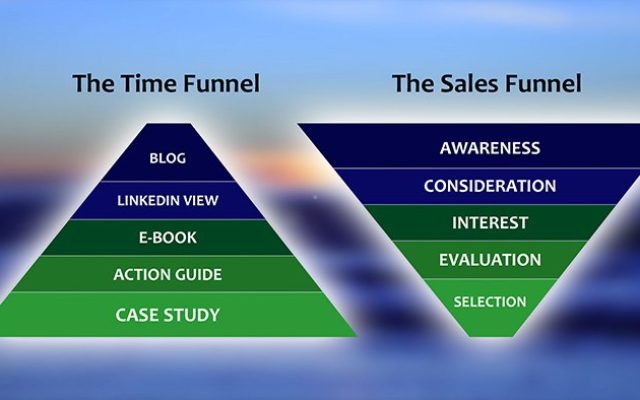You Need This To Acquire Organic Ideal Clients
I want to talk to you about a funnel. But it’s probably not the kind of funnel you are used to hearing about. You are likely quite familiar with the shape of the traditional sales funnel. It’s very wide on the top and then gradually narrows at the the bottom. But there is another funnel that I think is even more important for acquiring organic ideal clients.
I call it the “time funnel” and it is the single greatest indicator of sales readiness for organic inbound prospects. But here’s the funny part. The time funnel is the exact opposite shape of the sales funnel. The time funnel is very narrow at the top and very wide at the bottom.
This makes me wonder. Have we been looking at this thing the wrong way all along? Is there something that we, as professional service sales and marketing people, have been staring at for years without recognizing its value or significance? If acquiring organic ideal clients is a top goal for you, then I submit that you need to watch the time funnel very carefully. Here are my perspectives.
Three Key Concepts
Before I talk specifically about the time funnel, I want to describe three concepts that I think are of critical importance to service firms: organic ideal prospects, the inbound journey and content marketing. I want to make sure you understand how I think about these two topics so my later points make sense.
First, let’s talk about organic ideal prospects. In my experience, most service firms want to acquire more organic ideal clients. For every client I serve, acquisition of organic ideal clients is their number one business goal.
There are two words here that have a specific meaning to me. Let’s start with organic. An organic prospect is someone who:
- Has never done business with you.
- Was not in your database, was not a referral from an existing client or partner and was not in contact with you before they started their inbound journey.
- Knew very little about you before they started their inbound journey and you knew nothing about them.
- Was not predisposed to want to work with you and had no reason to say yes to you before they started their inbound journey.
This is how I think of organic prospects. They are truly new business.
Now let’s tackle that term “ideal.” To me, an ideal prospect is someone you are not doing business with today who will become a great client, in fact, an ideal client. What makes them ideal? There are seven major qualities that most service firms look for in an ideal client:
- Impact – you deliver services that have a significant impact on them, usually their top or bottom line or both.
- Budget – ideal clients easily afford your services and usually have already reserved a line item in their budget for those services.
- Profits – you earn a substantial profit by delivering these services.
- Insights – you understand what your ideal client needs often better than they do.
- Expertise – your ideal clients want and need your specific capabilities and have limited options for acquiring that expertise.
- Culture – there is a good fit between the way you do business and the way your ideal clients prefer to be served.
- Chemistry – your staff and your ideal clients’ staff work well together with few conflicts.
An organic ideal prospect is someone you haven’t done business with yet, but who is a perfect fit for your company and is inbound in your direction, taking a look at your company let’s say.
Now let’s look at that second concept, the inbound journey. This digital journey is something that organic inbound prospects usually take completely independent of human intervention. After analyzing the digital footprint of literally thousands of people, we see them consistently passing through four stages:
- Anonymous – where they surf your website and sample your content without identifying themselves.
- Acknowledged – where they register for a content asset and submit their personal information.
- Engaged – where they spend time thinking about your ideas and how you can help them.
- Leaning-in – where they are predisposed to want to enter serious dialogue with you as soon as they have need and budget.
More often than not, the reason they are taking this journey is both because they have a need and because you have created content that is compelling to them. This brings me to the third key concept I want to share with you – content marketing.
A lot of people use the term content marketing and it means different things to different people. Here is how I think of content marketing.
Content marketing is a set of ideas that tell organic inbound prospects how to achieve their goals, realize their opportunities and resolve their challenges. Content marketing is not a pitch about a company. This strategy puts the organic ideal prospect at the center of the process and gives them more rich ideas than they may have ever encountered before.
The content strategy that we recommend includes short-form and long-form content types. Short-form pieces, like blog-posts, give organic ideal prospects some great ideas. These pieces should conclude with a call to register for the long-form pieces which have even more great ideas.
The shape of those ideas and how they are packaged is of critical importance. Why? Because the shape of your content determines the shape of your time funnel. This shape impacts three things that are incredibly important to you:
- The number of organic ideal prospects who are inbound in your direction.
- The appropriateness of those prospects for your products and services.
- The velocity with which they move from cool to warm to hot.
___________________________________
Key Take-Away
The shape of your content determines the shape of your time funnel which determines the volume and velocity of organic ideal prospects leaning in to you.
___________________________________
The Sales Funnel
Before I give you the shape of the time funnel, I want to contrast this with the sales funnel, just so we’re both on the same page. Here are the stages of the sales funnel that most service firms need to navigate to close a new deal:
Awareness: Prospects become aware of your brand, products, services and content.
Consideration: Prospects sample your content to see how you can help them.
Interest: Prospects engage in serious dialogue, requesting a proposal.
Evaluation: Prospects evaluate your proposal against their needs and competitive offerings.
Selection: Prospects accept your proposal and move to next steps.
In the traditional way that sales and marketing people have thought about the sales funnel, there are only two things that seem to matter: the number of leads who go into the top of the funnel and the number of deals and clients who fall out of the bottom of the funnel.
To my way of thinking, this completely ignores the most important part of this funnel: the center. No one seems to be asking this critical question. How do “leads” go from cool to hot? More importantly, how can we know who is cool, warm or hot so we know with whom to engage?
I assure you that this question is of the utmost importance to business development consultants who have to sort through all of those “leads” that the marketing function generates. I’ve learned that lesson the hard way. Let me give you an example.
Let’s say you develop a webinar that tells ideal prospects how to achieve their goals. Let’s also assume that 500 people register for this webinar. Most service organizations would consider this a success. Let’s further assume that you have 5 business development consultants. Now what?
How should the 5 business development consultants take action on the 500 people who registered for your webinar? Should they call all of them? This would require 100 phone calls per consultant, which is a lot of labor, especially if they have existing deals they are working. Should they send an email? This would be 100 emails sent per consultant, which is also laborious.
Should you bulk email them and wait to see who raises their hand for a conversation? How can you know which of these “leads” are right for your business development consultants to be talking to? What can you reasonably expect of your business development team?
Now let’s extrapolate that result to an even larger level. Let’s assume that you not only conducted a webinar where 500 people registered, but you also used blogs, videos, e-books and case studies, just to name a few. Let’s assume that it’s not 500 people who seem to be interested, but 5,000 people. How can your business development consultants know with whom they should be following-up?
This is a conundrum I see every day and it is one of the biggest disconnects between the sales and marketing functions at service firms. This is also a root cause of frustration on the part of business development consultants, one of the major reasons they lose confidence in the marketing function. It is also a major source of missed deals and revenue.
But there is a strategy that can tip the odds substantially in their favor, can help them get to a deal much faster and with much higher certainty. It’s called the time funnel.
The Time Funnel
Unlike the sales funnel which looks wide at the top and narrow at the bottom, the time funnel looks narrow at the top and wide at the bottom. But here is the major difference between the two funnels.
The time funnel is a system of tracking unique individuals to assess their readiness for sales conversations. The sales funnel, on the other hand, is a way of tracking large groups of people who may be, but who are often not, ready for sales dialogue. Let me give you an example.
Let’s assume a management consulting firm has 3 business development consultants and a really sharp marketing team. The marketing team creates a blog-post about increasing profitability. The blog-post points to an e-book that tells their ideal prospects how to increase profits by 30% in less than 12 months. The e-book points to an action guide, a series of seven videos let’s say, on the same topic.
Let’s also assume that the management consulting firm has a marketing automation system that tracks lead score for individual users, something that is very common on most marketing automation systems today. The marketing automation system also tracks time-on-page and time-on-asset per individual user.
Let’s assume the following outcomes from the marketing activity:
- 2,500 people view the blog-post and 750 click through to the e-book.
- 500 people register for the e-book and 200 click over to the action guide.
- 100 people register for the action guide and start spending time with the videos.
How can these three consultants use the time funnel to discover which of the 2,500 people who entered the top of the sales funnel they should be following up with? I bet you are starting to see the logic here.
Remember when I said the shape of your content determines the shape of your time funnel? Here is what I meant by that.
I would recommend that this company create a filter in their marketing automation system to discover the people who fit certain time-based criteria. To enter this filter, prospects would need to have:
- Viewed the blog-post.
- Registered for the e-book.
- Registered for the action guide.
- Visited at least 5 of the 7 videos and spent at least 2 minutes per video.
This time funnel filter would narrow that list down from 2,500 people to about 25 people, a list size that is completely manageable for 3 business development consultants. More importantly, those 25 people would have spent a lot of time with the ideas that the management consulting firm has put forward about how to increase profits.
This would give the business development consultants a tremendous advantage. The prospects would already have bought in to, or at least been exposed to, key concepts that highlight the management consulting firm’s approach to improving profits.
Here is a critical point to understand. In today’s busy world, no one is going to give you their time unless they are interested in your ideas. So a gradual increase in time spent with your ideas is a clear indication of the value of those ideas.
For example, if someone spends 5 minutes with a blog-post, 30 minutes with an e-book and an hour or more with an action guide, their time investment speaks volumes about their interest. This is especially true for senior-level people who have budget authority and decision-rights. These people have the least amount of time to waste.
This is how the time funnel helps you get deals with organic ideal prospects much faster and with higher certainties of positive outcomes.
Next Steps To Build A Time Funnel
If you want to build a time funnel, I have a recommendation for you. I’ve developed an E-Book called Ten Things Service Websites Must Do To Drive Revenue. It goes into much greater detail on many of the concepts I’ve outlined in this blog-post. If you want to get mindshare with busy people, I know this E-Book will really help you.
About the author
Randy Shattuck is a senior marketing executive and founder of The Shattuck Group, a full-service marketing firm that specializes in growing professional services firms.
Article by channel:
Everything you need to know about Digital Transformation
The best articles, news and events direct to your inbox
Read more articles tagged: Featured






